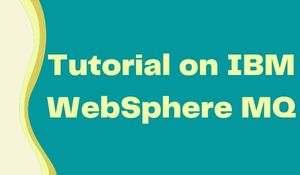
Websphere MQ in Brief
WebSphere MQ is an IBM product that was launched in March 1992. Initially, it was named as MQ series. In order to annex the collection of WebSphere products, it was then renamed IBM WebSphere MQ, commonly called MQ. IBM WebSphere MQ is robust messaging middleware for applications that simplifies and accelerates the integration of diverse applications. It sends messages across networks of diverse components. As it is platform-independent it allows independently and potentially non-concurrent applications on a distributed system however, it is a messaging and queuing middleware with point-to-point to securely communicate with each other regardless of where the application resides. Through messaging queues, IBM MQ facilitates the assured, secure and reliable exchange of information between applications, systems, services, and files by sending and receiving message data simplifying the creation and maintenance of business applications. It provides high performance, reliable, secure, and scalable message transfer for messages. It delivers Universal Messaging with a broad set of offerings to meet enterprise-wide messaging needs, as well as connectivity for the internet of things and mobile devices. It is also available for a large number of operating systems including IBM and non-IBM, mainframe, AS/400, AIX, HP-UX, Solaris, Linux, Microsoft Windows, and many others. IBM WebSphere MQ encounters transferring the message by handling the different processors, operating systems, subsystems, and communication protocols. To connect to IBM WebSphere MQ an application has a choice of programming interfaces and programming languages. These Applications can publish messages to many subscribers over multicast. Through the Windows Explorer and UNIX/AIX Command-line interface one can start working with control and WebSphere MQ script commands. MQSeries runs on a variety of platforms. Across all the platforms MQSeries programs use a consistent application program interface (API). Assured delivery means once the platforms are having a backup within the system it will still be delivered even if the hardware or software platform crashes the messages. The MQSeries products enable programs to communicate with one another across a network of certain components, such as processors, subsystems, operating systems, and communication protocols. On a major target system, MQSeries consists of a queue manager and a number of queues and channels.

Queues
A queue is a container of messages. Generally, messages are retrieved from the front of the queue whereas New messages are placed at the end of the queue. MQ allows asynchronous communication by placing a queue between the producer of a message and the consumer. The producer can send a message without knowing whether the consumer of that message is currently available. If required consumer can then send a reply to that message back to the producer if required.
Channels
The queue managers within the infrastructure are connected with channels. Messages automatically flow across these channels, from the initial producer of a message to the consumer of that message, based on the configuration of the queue managers in the infrastructure.
Message in MQ
A WebSphere MQ Series message is merely a collection of data sent by one program and intended for another program. The message consists of application-specific data and control information. In order to route the message between the programs, controlling information is required. A message can be classed as persistent or non-persistent. A persistent message once communicated to a queue manager, will survive a software or hardware crash and reboot, whereas a non-persistent message will not survive. Persistent messages are used as part of the implementation of the assured delivery service supported by MQSeries.
Anatomy of an MQ system
1. Applications
- Applications use MQ clients to connect to an MQ queue manager
- Applications can connect to queue managers either on the same system which is Bindings mode or remotely over a network Client mode.
2. Queue Managers
- A queue manager is a runtime that hosts messaging resources such as queues and their messages
- A queue manager manages the flow and storage of messages
- Each queue manager runs on a single system
- Multiple queue managers can be connected together using channels and messages routed between them
3. Queues
Queues are a named resource where messages sent to by applications, stored by the queue manager and retrieved by applications.
4. Messages
- These are just chunks of data
- Applications build messages to send and receive
5. Channels
- Channels define a way for one queue manager to connect to another queue manager
- Channels can be manually configured or dynamically created as and when needed using MQ Clusters
Advantages of IBM-MQ
- A WebSphere MQ client facility is not required on the gateway WebSphere MQ queue manager.
- A managed connection from one node to another node is created, but not from every application server in the cell.
- To the service integration bus, we do not have to define individual WebSphere MQ queues
- Can control which all users are allowed to put messages onto queues where good security support is provided.
- On separate hosts, WebSphere Application Server and WebSphere MQ can exists.
- There is an absolute interaction between WebSphere Application Server and WebSphere MQ
- As an external JMS messaging provider there can be a direct connection to WebSphere MQ and a better performance over the link is possible when compared with WebSphere MQ servers.
- WebSphere MQ appears to service integration to be a foreignbus, service integration appears to WebSphere MQ to be a virtual queue manager.
- You can configure a publish and subscribe bridge, through which WebSphere Application Server applications can subscribe to messages published by WebSphere MQ applications, and WebSphere MQ applications can subscribe to messages published by WebSphere Application Server applications.
Disadvantage of IBM-MQ
- Configure a service integration bus and messaging engines must be configured.
- In bindings mode we cannot connect to queue managers.
- Cannot use service integration mediations for modifying messages, routing, or logging.
- Optimum load balancing is simpler and easy to achieve because messages have to be pushed from either end of the link.

Conclusion
IBM Websphere MQ Online Training at Gologica provides flexibility in learning, will help you master all the essentials of the IBM WebSphere Message Queue right from basic to expert level through real-time examples. A superior level comprehension of protest arranged programming idea, expected to run the program and execute work easily. You will gain expertise in administering IBM MQ queue managers on the distributed operating systems through industry use cases. Candidates having experience in developing business application programs in C and a basic understanding of the messaging and queuing model and its implementation in WebSphere MQ. Certified WMQ professionals are among the highest-paid IT professionals today. Enroll with us, Happy Learning!!
Author Bio

Kavya Sathvik, A content strategist at Gologica. She has 2 years of experience in content writing. Passionate about writing technical content and also creating effective content strategy for a brand or blogs. Contact her: Linkedin
Drop An Enquiry
Search
COURSE CATEGORIES
- Agile
- APIGEE
- Articles
- BIG Data&Hadoop
- Cloud Computing
- Cyber Security
- Data Science Tutorial
- DevOps
- Digital Marketing Tutorial
- ElasticSearch
- Fusion
- Fusion Middleware
- Hyperion
- IBM
- Interview Questions
- Java
- JIRA
- LANGUAGES
- Microsoft
- Mobile Applications
- Net Suite
- Networking
- Oracle
- PEOPLESOFT
- RPA
- RSA ARCHER
- SAP
- SAS
- SEO
- SIEBEL
- Testing
- Tibco
- Tutorials
- Uncategorized
- Web Center
- Web Methods
- Web Technologies
- Workday
